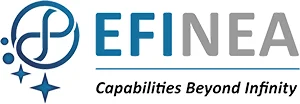EFINEA is a leading distributor of Tungsten Heavy Alloys (WHA) and provides this guide on machining these alloys as an overview. Tungsten is alloyed with different elements such as Nickel, Copper and Iron to produce a large variety of Tungsten Alloy grades. Many of these alloy grades have engineering properties similar to Steel making them relatively easy to machine. Also, these alloys can be drilled, milled, turned and tapped using standard tools and equipment, while using speeds and feeds similar to Grey Cast Iron. In fact, Tungsten alloys can also be plated or painted to enhance their corrosion protection.
Tools
C-2 Grade carbide tooling is recommended. Use as generous a nose radius as possible.
Operations
- Turning/Boring: Positive rake is recommended.
- Roughing: 0.050″/ 0.200″ Depth of Cut: 0.008″/.010″ Feed.
- Finishing: 0.010″/0.030″ Depth of Cut: 0.003″/0.005″ Feed.
- Turning Speed: 250/350 Surface feet per minute.
Note: For above operations, air is the preferred method of cooling tools; coolant can be used.
Drilling/Tapping
- Drilling: Use carbide tipped or solid carbide drills with air or coolant such as molydisulfide cutting fluid. Drill tap holes to 50-55% of thread hole requirement.
- Tapping: Use straight flute, high alloy taps. For small threaded holes, thread forming. taps can be used. Nitrided or solid carbide taps will extend life of tap on long run jobs.
Grinding
Use aluminum oxide type wheels (“J” grade typical) with coolant to remove grinding material rapidly.
Milling
Feeds and speeds should follow grey cast iron recommendations.
- Feeds: 0.003” per tooth as a starting point.
- Speed: 75 – 750 sfpm with carbide tools; adjust to depth of cut.
- End Milling: Slight “climb” is best starting point.
Note: For above operations, air is the preferred method of cooling tools; coolant can be used.
Exotic Operations
Wire EDM; Solid EDM; Waterjet cutting can be performed on tungsten alloys.
Guide to Machining Tungsten Heavy Alloys Download PDF
The information and data presented are typical or average values and are not a guarantee of maximum or minimum values. Applications specifically suggested for materials described herein are made solely for the purpose of illustration to enable readers to make their own evaluation and are not intended as warranties, either expressed or implied.

